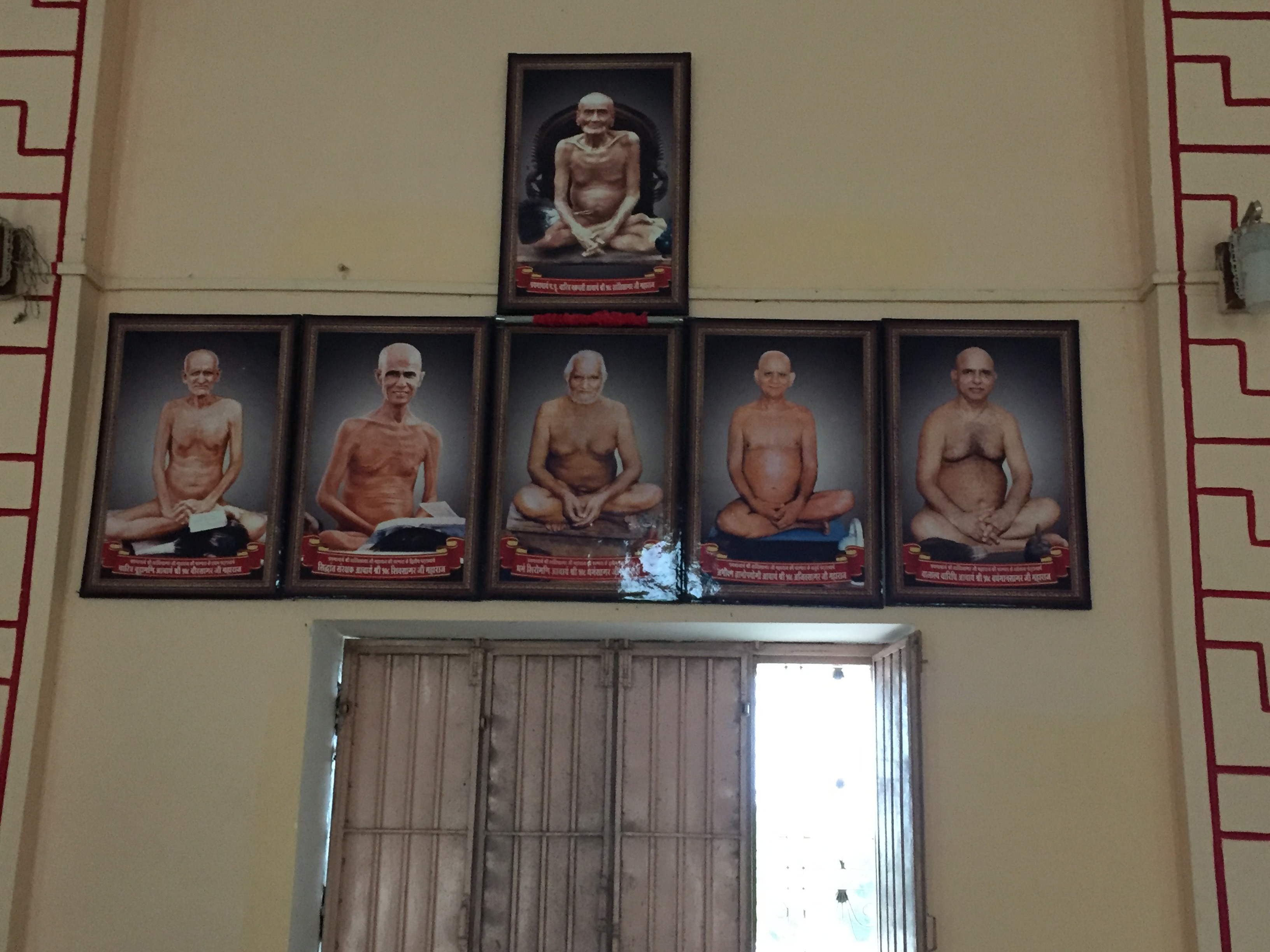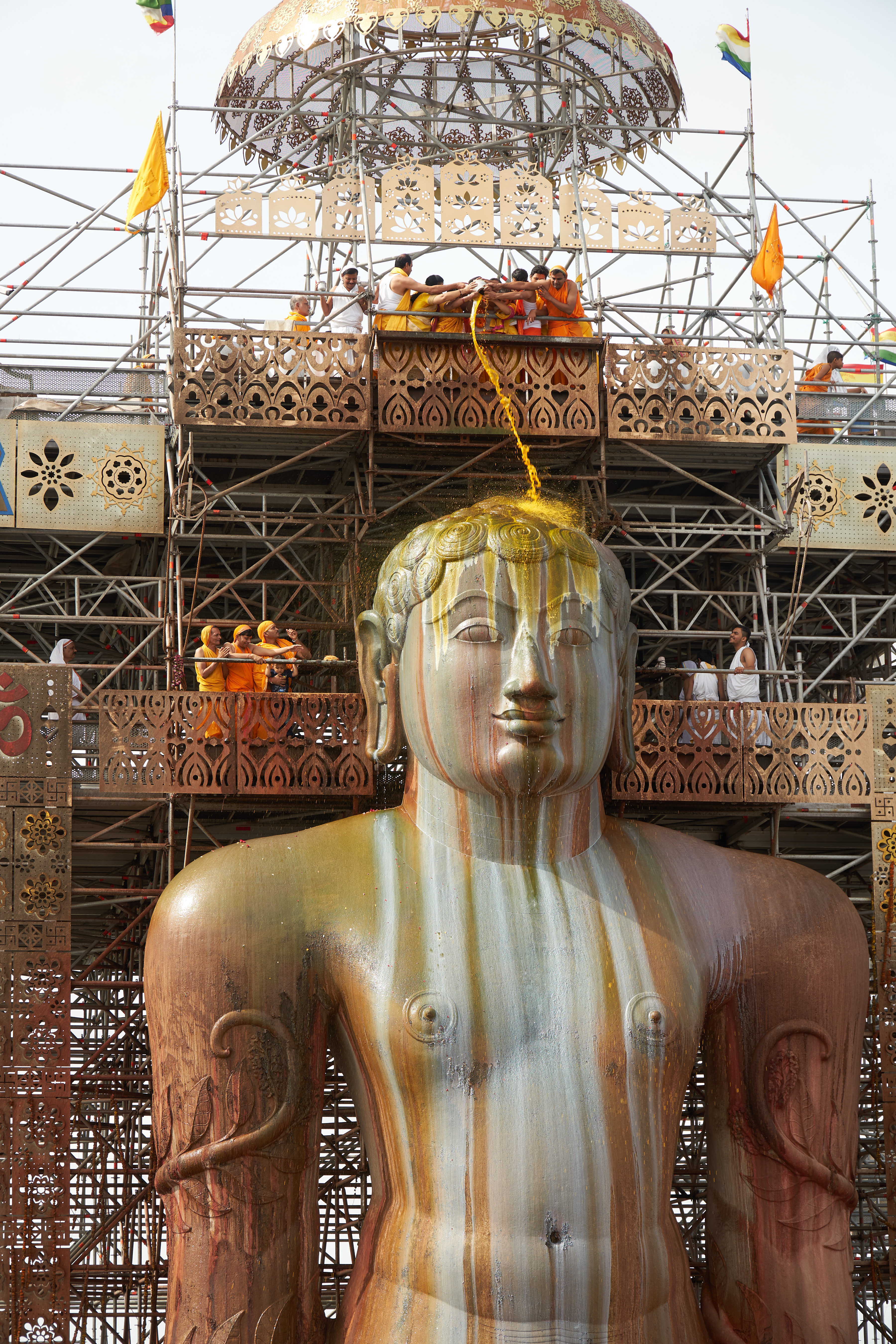|
Acharya Shantisagar
Acharya Shri Shantisagar (1872–1955) was an Indian monk of the Digambara school of the Jain faith. He was the first Acharya (preceptor) and a leader of his sect in the 20th century. Shanti Sagar ji revived the teaching and practice of traditional Digambara practices in North India. He was lustrated as a kshullaka into the Sangha (holy order) by Devappa (Devakirti) Swami. He took his ailaka deeksha (religious vows) before an image of the Tirthankara Neminatha. In about 1920, Shantisagar became a full muni (monk) of the Digambara sect of Jainism. In 1922, at Yarnal village, Belgaum district, Karnataka, he was given the name "Shanti Sagara" ("Ocean of Peace"). Early life Shantisagar ji were born in 1872 near Bhoj village, Belgavi district Karnataka, India. His father either worked as a farmer or was employed in the clothing business. At age eighteen, having read religious texts and undergone several pilgrimages, Shantisagar Ji decided to dedicate his life to a religious order. ... [...More Info...] [...Related Items...] OR: [Wikipedia] [Google] [Baidu] |
Acharya (Jain)
In Indian religions and society, an ''acharya'' (Sanskrit: आचार्य, IAST: ; Pali: ''ācariya'') is a preceptor and expert instructor in matters such as religion, or any other subject. An acharya is a highly learned person with a title affixed to the names of learned subject. The designation has different meanings in Hinduism, Buddhism and secular contexts. ''Acharya'' is sometimes used to address an expert teacher or a scholar in any discipline, e.g.: Bhaskaracharya, the expert mathematician. Etymology The Sanskrit phrase ''Acharam Grahayati Acharam Dadati Iti Va'' means ''Acharya'' (or teacher) is the one who teaches good conduct to one's students. A female teacher is called an ''achāryā,'' and a male teacher's wife is called an ''achāryāni'' In Hinduism In Hinduism, an ''acharya'' is a formal title of a teacher or guru, who has attained a degree in Veda and Vedanga. Prominent acharyas in the Hindu tradition are as given below : *Adi Sankaracharya *Ramanu ... [...More Info...] [...Related Items...] OR: [Wikipedia] [Google] [Baidu] |
Lustration
Lustration is the purge of government officials in Central and Eastern Europe. Various forms of lustration were employed in post-communist Europe. Etymology Lustration in general is the process of making something clear or pure, usually by means of a propitiatory offering. The term is taken from the ancient Roman lustratio purification rituals. Background According to a 1992 constitutional amendment in the Czech Republic, a person who publicly denies, puts in doubt, approves, or tries to justify Nazi or Communist genocide or other crimes of Nazis or Communists will be punished with a prison term of six months to three years. In 1992, Barbara Harff wrote that no Communist country or governing body had been convicted of genocide. In his 1999 foreword to ''The Black Book of Communism'', Martin Malia wrote: "Throughout the former Communist world, moreover, virtually none of its responsible officials has been put on trial or punished. Indeed, everywhere Communist parties, tho ... [...More Info...] [...Related Items...] OR: [Wikipedia] [Google] [Baidu] |
Nagpur
Nagpur (pronunciation: Help:IPA/Marathi, [naːɡpuːɾ]) is the third largest city and the winter capital of the Indian state of Maharashtra. It is the 13th largest city in India by population and according to an Oxford's Economics report, Nagpur is projected to be the fifth fastest growing city in the world from 2019 to 2035 with an average growth of 8.41%. It has been proposed as one of the Smart Cities Mission, Smart Cities in Maharashtra and is one of the top ten cities in India in Smart Cities Mission, Smart City Project execution. In the latest rankings of 100 developing smart cities given by the Union Ministry of Urban Development (Maharashtra), Ministry of Urban Development, Nagpur stood first in Maharashtra state and second in India. Known as the "Orange City", Nagpur has officially become the greenest, safest and most technologically developed city in the Maharashtra state. Nagpur is the seat of the annual Winter Session of Maharashtra State Assembly, winter session ... [...More Info...] [...Related Items...] OR: [Wikipedia] [Google] [Baidu] |
Nanded
Nanded is a city in Maharashtra state, India. It is the tenth largest city in the state and the seventy-ninth most populous city in India. It is the second largest city in Marathwada region. It is the district headquarters of Nanded district. The last Sikh Guru, Guru Gobind Singh spent his last days in Nanded and passed his guruship to the sacred text Guru Granth Sahib before his death here in 1708. Location Nanded is located on the banks of river Godavari in west-central India. Nanded district borders Latur district, Parbhani district and Hingoli district to the west and Yavatmal district to the north. The district is bordered by the Nizamabad, Kamareddy, Nirmal and Adilabad districts of Telangana state to the east and Bidar district of Karnataka state to the south. Nanded has two parts: Old Nanded occupies the north bank of the Godavari river; New Nanded, to the south of the river, encompasses Waghala and neighbourhoods. Etymology From a copper plate inscription ... [...More Info...] [...Related Items...] OR: [Wikipedia] [Google] [Baidu] |
Shravanbelgola
Shravanabelagola () is a town located near Channarayapatna of Hassan district in the Indian state of Karnataka and is from Bengaluru. The Gommateshwara Bahubali statue at Shravanabelagola is one of the most important tirthas (pilgrimage destinations) in Jainism, one that reached a peak in architectural and sculptural activity under the patronage of Western Ganga dynasty of Talakad. Chandragupta Maurya is said to have died here in 298 BCE after he became a Jain monk and assumed an ascetic life style. Gommateshwara statue, Akkana Basadi, Chandragupta basadi, Chamundaraya Basadi, Parshvanath Basadi and inscriptions of Shravanabelagola group of monuments are listed as Adarsh Smarak Monument by Archaeological Survey of India. Location Shravanabelagola is located at to the south-east of Channarayapatna in the Channarayapatna taluk of Hassan district of Karnataka. It is at a distance of south-east of Hassan, Karnataka, the district centre. It is situated at a distance of to t ... [...More Info...] [...Related Items...] OR: [Wikipedia] [Google] [Baidu] |
Mahamastakabhisheka
The ''Mahamastakabhisheka'' ("Grand Consecration", "The Great Indian Festival") refers to the '' abhiṣeka'' (anointment) of the Jain images when held on a large scale. The most famous of such consecrations is the anointment of the Bahubali Gommateshwara statue located at Shravanabelagola in Karnataka, India. It is an important Jain festival held once every 12 years. It is an integral part of the ancient and composite Jain tradition. The festival is held in veneration of a high monolithic statue of the Siddha Bahubali. The anointing last took place in February 2018, and the next ceremony will take place in 2030. The ceremony in 2018 is said to be the 88th in the series that commenced in the year 981 AD and was the second Mahamastakabhisheka of the 21st century. The ceremony is expected to be graced by numerous Jain ascetics. The February 2018 event was held under the leadership of Charukeerthi Bhattaraka Swamiji of Shravanabelagola from 17 to 25 February 2018. Anointmen ... [...More Info...] [...Related Items...] OR: [Wikipedia] [Google] [Baidu] |
Sammed Shikhar
Shri Sammet Shikharji () is a pilgrimage site in Giridih district, Jharkhand, India. It is located on Parasnath hill, the highest mountain in the state of Jharkhand. It is the most important Jain Tirtha (pilgrimage site) by both Digambara and Śvētāmbara, for it is the place where twenty of the twenty-four Jain tirthankaras along with many other monks attained Moksha. Etymology ''Shikharji'' means the "venerable peak". The site is also called Sammet Śikhar "peak of concentration." because it is a place where twenty of twenty-four Tirthankaras attained Moksha through meditation. The word "Parasnath" is derived from Parshvanatha, the twenty-third Jain Tirthankara, who was one of those who is believed to have attained Moksha at the site. Geography Shikarji is located in an inland part of rural east India. It lies on NH-2, the Delhi-Kolkata highway in a section called the Grand Trunk road Shikharji rises to making it the highest mountain in Jharkhand state. Jain traditi ... [...More Info...] [...Related Items...] OR: [Wikipedia] [Google] [Baidu] |
Padmanabh Jaini
Padmanabh Shrivarma Jaini (October 23, 1923 - May 25, 2021) was an Indian born scholar of Jainism and Buddhism, living in Berkeley, California, United States. He was from a Digambar Jain family; however he was equally familiar with both the Digambara and Svetambara forms of Jainism. He has taught at the Banaras Hindu University, the School of Oriental and African Studies (SOAS), the University of Michigan at Ann Arbor and at the University of California at Berkeley, from which he retired in 1994. Professor Jaini was the author of several books and papers. His best known work is ''The Jaina Path of Purification'' (1979). Some of his major articles have been published under these titles: ''The Collected Papers on Jaina Studies'' (2000) and ''Collected Papers on Buddhist Studies'' (2001). He died on 25 May 2021 at Berkeley at age 97. Early life and education Jaini was born to a Digambar Jain family residing in Nellikar, a small town near Moodabidri, Karnataka, India on October ... [...More Info...] [...Related Items...] OR: [Wikipedia] [Google] [Baidu] |
Jain Acharya Parampara
Jainism ( ), also known as Jain Dharma, is an Indian religion. Jainism traces its spiritual ideas and history through the succession of twenty-four tirthankaras (supreme preachers of ''Dharma''), with the first in the current time cycle being Rishabhadeva, whom the tradition holds to have lived millions of years ago, the twenty-third ''tirthankara'' Parshvanatha, whom historians date to the 9th century BCE, and the twenty-fourth ''tirthankara'' Mahavira, around 600 BCE. Jainism is considered to be an eternal '' dharma'' with the ''tirthankaras'' guiding every time cycle of the cosmology. The three main pillars of Jainism are ''ahiṃsā'' (non-violence), ''anekāntavāda'' (non-absolutism), and '' aparigraha'' (asceticism). Jain monks, after positioning themselves in the sublime state of soul consciousness, take five main vows: ''ahiṃsā'' (non-violence), '' satya'' (truth), '' asteya'' (not stealing), '' brahmacharya'' (chastity), and '' aparigraha'' (non-possessiveness). ... [...More Info...] [...Related Items...] OR: [Wikipedia] [Google] [Baidu] |
British Raj
The British Raj (; from Hindi ''rāj'': kingdom, realm, state, or empire) was the rule of the British Crown on the Indian subcontinent; * * it is also called Crown rule in India, * * * * or Direct rule in India, * Quote: "Mill, who was himself employed by the British East India company from the age of seventeen until the British government assumed direct rule over India in 1858." * * and lasted from 1858 to 1947. * * The region under British control was commonly called India in contemporaneous usage and included areas directly administered by the United Kingdom, which were collectively called British India, and areas ruled by indigenous rulers, but under British paramountcy, called the princely states. The region was sometimes called the Indian Empire, though not officially. As ''India'', it was a founding member of the League of Nations, a participating nation in the Summer Olympics in 1900, 1920, 1928, 1932, and 1936, and a founding member of the United Nations in San F ... [...More Info...] [...Related Items...] OR: [Wikipedia] [Google] [Baidu] |
Hunger Strike
A hunger strike is a method of non-violent resistance in which participants fast as an act of political protest, or to provoke a feeling of guilt in others, usually with the objective to achieve a specific goal, such as a policy change. Most hunger strikers will take liquids but not solid food. In cases where an entity (usually the state) has or is able to obtain custody of the hunger striker (such as a prisoner), the hunger strike is often terminated by the custodial entity through the use of force-feeding. Early history Fasting was used as a method of protesting injustice in pre-Christian Ireland, where it was known as ''Troscadh'' or ''Cealachan''. Detailed in the contemporary civic codes, it had specific rules by which it could be used. The fast was often carried out on the doorstep of the home of the offender. Scholars speculate that this was due to the high importance the culture placed on hospitality. Allowing a person to die at one's doorstep, for a wrong of which o ... [...More Info...] [...Related Items...] OR: [Wikipedia] [Google] [Baidu] |








